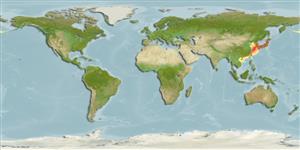Environment: milieu / climate zone / depth range / distribution range
Écologie
marin démersal; profondeur 0 - 200 m (Ref. 43239), usually 0 - 20 m (Ref. 43239). Temperate
Northwest Pacific: Japan and Korea (Ref. 37630).
Length at first maturity / Taille / Poids / Âge
Maturity: Lm ?, range 15 - ? cm
Max length : 30.0 cm SL mâle / non sexé; (Ref. 559)
Description synthétique
Clés d'identification | Morphologie | Morphométrie
Épines dorsales (Total) : 76 - 83; Rayons mous dorsaux (Total) : 0; Épines anales: 2; Rayons mous anaux: 35 - 42; Vertèbres: 83 - 90.
Facultative air-breathing in the genus (Ref. 126274); Found in tide pools or the intertidal zone to 20 m depth, on sandy-mud bottoms and among rocks of rocky reefs (Ref. 43239); also in eelgrass (Zostera marina) beds (Ref. 559). Sometimes to 200 m depth (Ref. 43239). Feeds on gammarids. Juveniles associate with drifting seaweed (Ref. 12114, 12115). Although rarely used for commercial food, this species is highly valued as fried fish in the spring months in Tokyo and neighboring areas (Ref. 7031).
Life cycle and mating behavior
Maturities | Reproduction | Spawnings | Egg(s) | Fecundities | Larves
Nakabo, T., 2002. Fishes of Japan with pictorial keys to the species, English edition II. Tokai University Press, Japan, pp 867-1749. (Ref. 43239)
Statut dans la liste rouge de l'IUCN (Ref. 130435)
Menace pour l'homme
Harmless
Utilisations par l'homme
Outils
Articles particuliers
Télécharger en XML
Sources Internet
Estimates based on models
Preferred temperature (Ref.
123201): 13.2 - 22.7, mean 18.3 °C (based on 94 cells).
Phylogenetic diversity index (Ref.
82804): PD
50 = 0.5005 [Uniqueness, from 0.5 = low to 2.0 = high].
Bayesian length-weight: a=0.00257 (0.00157 - 0.00420), b=3.27 (3.13 - 3.41), in cm total length, based on LWR estimates for this species & (Sub)family-body (Ref.
93245).
Niveau trophique (Ref.
69278): 3.2 ±0.32 se; based on food items.
Generation time: 1.5 ( na - na) years. Estimated as median ln(3)/K based on 1
growth studies.
Résilience (Ref.
120179): Haut, temps minimum de doublement de population inférieur à 15 mois (K=0.7).
Fishing Vulnerability (Ref.
59153): Low vulnerability (22 of 100).
